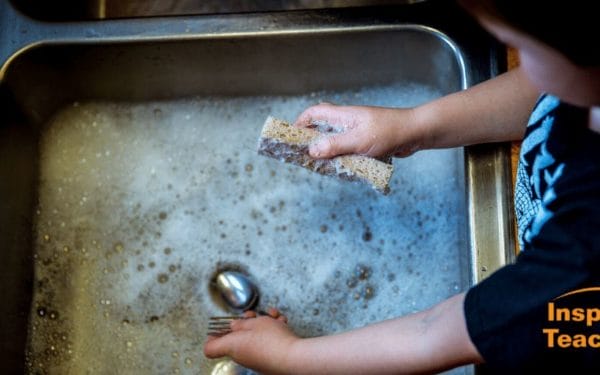The following activity is part of a series we’re creating to support students, teachers, and caregivers, during this unprecedented time. Read more about the project here. If you try this activity with your student(s), we’d love to see what you do. Share your journey via the #Inspired2Learn hashtag on your preferred social platform.
Created by: Jenna Fournel
Discipline: Science, Writing
Age level: Elementary and Middle
Time: depends on how far you want to take each activity
Materials: a variety of soap products and basic household materials
We’re all using soap to wash our hands more than usual, what else can you do with that slippery bubbly substance? Below are some ideas to get you and your students started. You can build each idea out into an extensive lesson, if you want. But you can also offer your students these options and let them engage in their own Learning Through Play, then ask them to report back about what they’ve learned. Note: If soap is a limited resource in your home right now, then modify accordingly – i.e. see how many bubbles you can create with one drop of soap; observe the viscosity of soap (by turning the bottle upside down and watching the soap move inside); etc.
- Figure out how to turn a solid bar of soap into liquid soap.
- Fill a bowl with soapy water and try using different utensils to see what makes the bubbles biggest (i.e. a fork, an egg beater, chopsticks, your hands, a spoon, etc.). Try to figure out why the thing that works the best, works.
- Make a big pile of bubbles in a bowl and then test different substances to make them pop (i.e. vinegar, milk, oil, more soap, etc.). Try to figure out why the thing that works the best, works.
- Sprinkle pepper into a bowl of water, then put a dot of soap in the middle and see what happens. Can you figure out why that happens? Does the same thing happen with other substances you sprinkle on the water?
- Test different water/liquid soap ratios to figure out what makes the biggest bubbles. Can you add other things to your mixtures to make the bubbles stronger, more colorful, scented, what else?
- Create packaging for a brand new kind of soap of your own invention.
- See what happens if you put soap in the microwave. Does it change the soap’s properties? Don’t put it in for too long!
- Test every kind of soap you can find in your home to see which creates the best lather.
- Find a floor in your home that could use some washing and test out different soaps on different sections of the floor to see which does the best job of getting it clean.
- Cover a sponge or cloth in oil, then test different soaps to see which gets it most clean. Environmentalists have had to test different soaps to figure out which works best to clean animals affected by oil spills. Look online to see what they found that works.
Inspired Teaching Connection
Each of these activities engages students in purpose (there is a clear objective to the task), persistence (they have to puzzle through their ideas to see what works), and action (they are all hands-on). Putting the students at the center of the learning rather than telling them what will work builds interest and taps into their intellects, and engages them in the Wonder-Experiment-Learn Cycle. The bonus? Super clean hands.
See our instructional model here.

